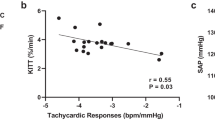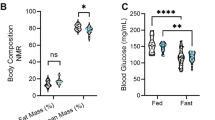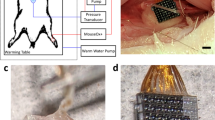Abstract
Erectile dysfunction is related to metabolic alterations produced by a high carbohydrate diet, which may affect muscle activity during penile reflex in adulthood. We determined whether sucrose water consumption during gestation lactation and postweaning affects pubococcygeus muscle (Pcm) activity during urethrogenital reflex in adult male rat offspring. Twelve female rats were mated and grouped in control mothers consumed tap water and sucrose mothers consumed sucrose water during gestation lactation. Male pups were weaned and assigned into four groups (n = 6 each): those from control mothers who continued drinking tap water (CM–CO group) or sucrose water (CM–SO group) until adult life, and those from sucrose mothers who drank tap water (SM–CO group) or continued drinking sucrose water (SM–SO group) until adult life. Body weight, Pcm activity during penile stimulation by bipolar electrodes and urethrogenital reflex were analyzed. A catheter was placed into the urethra to record variations in urethral pressure after mechanical stimulation. Two-way ANOVA followed by post hoc tests were used considering P ≤ 0.05 as a significant difference. Males from the SM–SO group showed weight gain compared to the control group (P < 0.001). Also, sucrose intake promoted high Pcm activity (P < 0.0001) but reduced urethrogenital reflex duration CM–CO vs CM–SO (P = 0.02); CM–CO vs SM–CO (P = 0.01); CM–SO vs SM–SO (P < 0.003); and SM–CO vs SM–SO (P < 0.002). Our results suggest that a combination of a sucrose-rich diet during gestation lactation and postweaning modifies Pcm activation during penile reflex. The urethrogenital reflex is a spinal ejaculatory-like reflex, these rats could have penile dysfunction equivalent to premature ejaculation in men.
This is a preview of subscription content, access via your institution
Access options
Subscribe to this journal
Receive 8 print issues and online access
$259.00 per year
only $32.38 per issue
Buy this article
- Purchase on Springer Link
- Instant access to full article PDF
Prices may be subject to local taxes which are calculated during checkout







Similar content being viewed by others
References
Jeh SU, Yoon S, Choi JH, Do J, Seo DH, Lee SW, et al. Metabolic syndrome is an independent risk factor for acquired premature ejaculation. World J Mens Health. 2019;37:226.
Groutz A, Gordon D, Schachter P, Amir H, Shimonov M. Effects of bariatric surgery on male lower urinary tract symptoms and sexual function. Neurourol Urol. 2017;36:636–9.
Du M, Yan X, Tong JF, Zhao J, Zhu MJ. Maternal obesity, inflammation, and fetal skeletal muscle development. Biol Reprod. 2010;82:4–12.
Bayol SA, Bruce CR, Wadley GD. Growing healthy muscles to optimise metabolic health into adult life. J Dev Orig Health Dis. 2014;5:420–34.
Burnett AL. Novel nitric oxide signaling mechanisms regulate the erectile response. Int J Impot Res. 2004;16:15–19.
Ford SP, Hess BW, Schwope MM, Nijland MJ, Gilbert JS, Vonnahme KA, et al. Maternal undernutrition during early to mid-gestation in the ewe results in altered growth, adiposity, and glucose tolerance in male offspring. J Anim Sci. 2007;85:1285–94.
Huber K, Miles JL, Norman AM, Thompson NM, Davison M, Breier B. Prenatally induced changes in muscle structure and metabolic function facilitate exercise-induced obesity prevention. Endocrinology. 2009;150:4135–44.
Yan X, Huang Y, Zhao JX, Long NM, Uthlaut AB, Zhu MJ, et al. Maternal obesity-impaired insulin signaling in sheep and induced lipid accumulation and fibrosis in skeletal muscle of offspring. Biol Reprod. 2011;85:172–8.
Huang Y, Zhao JX, Yan X, Zhu MJ, Long NM, McCormick RJ, et al. Maternal obesity enhances collagen accumulation and cross-linking in skeletal muscle of ovine offspring. PLoS ONE. 2012;7:e31691 https://doi.org/10.1371/journal.pone.0031691.
Salto R, Girón MD, Manzano M, Martín MJ, Vílchez JD, Bueno VP, et al. Programming skeletal muscle metabolic flexibility in offspring of male rats in response to maternal consumption of slow digesting carbohydrates during pregnancy. Nutrients. 2020;12:e528. https://doi.org/10.3390/nu12020528.
Wu H, Ballantyne CM. Skeletal muscle inflammation and insulin resistance in obesity. Clin Investig. 2017;127:43–54.
Akhmedov D, Berdeaux R. The effects of obesity on skeletal muscle regeneration. Front Physiol. 2013;4:371.
Seppan P, Muhammed I, Mohammad ZIK, Sathyanathan SB. Pathobiology of ischiocavernosus and bulbospongiosus muscles in long-term diabetic male rats and its implication on erectile dysfunction. Aging Male. 2019;1:1–12.
Manzo J, Esquivel A, Hernández ME, Carrillo P, Martínez–Gómez M, Pacheco P. The role of pubococcygeus muscle in urinary continence in the male rat. J Urol. 1997;157:2402–6.
Alvarado M, Cuevas E, Lara M, Camacho M, Carrillo P, Hudson R, et al. Effect of gonadal hormones on the cross-sectional area of pubococcygeus muscle fibers in male rat. Anat Rec. 2008;291:586–92.
Tanahashi M, Karicheti V, Thor KB, Marson L. Characterization of bulbospongiosus muscle reflexes activated by urethral distension in male rats. Am J Physiol Regul Integr Comp Physiol. 2012;303:737–47.
Carro-Juárez M, Rodríguez-Manzo M, Rodrıíguez-Peña ML, Franco MA. Rhythmic motor patterns accompanying ejaculation in spinal cord-transected male rats. Int J Impot Res. 2014;26:191–5.
Xicohténcatl RI, Corona-Quintanilla DL, Nicolás L, Martínez-Gómez M, Cuevas E, Castelán F, et al. The role of the pubococcygeous muscle in the urethrogenital reflex of male rats. Neurourol Urodyn. 2017;36:80–85.
Fritsch H, Fröhlich B. Development of the levator ani muscle in human fetuses. Early Hum Dev. 1994;37:15–25.
Wallner C, van Wissen J, Maas CP, Dabhoiwala NF, DeRuiter MC, Lamers WH. The contribution of the levator ani nerve and the pudendal nerve to the innervation of the levator ani muscles; a study in human fetuses. Eur Urol. 2008;54:1136–142.
Oron HM, Kamari Y, Grossman E, Yeger G, Peleg E, Shabtay Z, et al. Metabolic syndrome: comparison of the two commonly used animal models. Am J Hypertens. 2008;21:1018–22.
Cervantes RM, Martínez-Gómez M, Cuevas E, Nicolás L, Castelán F, Nathanielsz PW, et al. Sugared water consumption by adult offspring of mothers fed a protein-restricted diet during pregnancy results in increased offspring adiposity: the second hit effect. Br J Nutr. 2014;111:616–24.
Erhuma A, Bellinger L, Langley ESC, Bennett JA. Prenatal exposure to undernutrition and programming of responses to high-fat feeding in the rat. Br J Nutr. 2007;98:517–24.
Malik VS, Popkin MB, Bray AG, Després PJ, Willett CW, Hu BF. Sugar-sweetened beverages and risk of metabolic syndrome and type 2 diabetes: a meta-analysis. Diabetes Care. 2010;33:2477–83.
Manzo J, Vazquez MI, Cruz MR, Hernández EM, Carrillo P, Pacheco P. Fertility ratio in male rats: effects after denervation of two pelvic floor muscles. Physiol Behav. 2000;68:611–8.
Confortim DH, Jerônimo CL, Centenaro AL, Pinheiro FFP, Matheus MMS, Torrejais MM. Maternal protein restriction during pregnancy and lactation affects the development of muscle fibers and neuromuscular junctions in rats. Muscle Nerve. 2017;55:109–15.
Chess WR. The use of α-adrenoceptor antagonists in lower urinary tract disease. Expert Opin Pharmacother. 2002;3:167–72.
Albers HP, Pedersen TJA, Birk BJ, Kristensen ED, Vind FB, Baba O, et al. Human muscle fiber type-specific insulin signaling: impact of obesity and type 2 diabetes. Diabetes 2015;64:485–97.
Mora S, Yang C, Ryder JW, Boeglin D, Pessin EJ. The MEF2A and MEF2D isoforms are diffretentially regulated in muscle and adipose tissue during states of insulin deficiency. Endocrinology. 2001;142:1999–2004.
Oliveira PTR, Manhães-de-Castro R, Silva MJ, Burbano CVE, Cavalcanti LCC, Benjamim CAR, et al. Differential effects of maternal high-fat/high-caloric or isocaloric diet on offspring’s skeletal muscle phenotype. Life Sci. 2018;215:136–44.
Alves-Pereira JL, Frantz CDE, Pires SAL, Babinski AM, Ramos FDC. Effects of a high energy density diet in the “corpus cavernosum” of mice. Int J Impot Res. 2019;31:126–31.
Dursun M, Besiroglu H, Cakir SS, Otunctemur A, Ozbek E. Increased visceral adiposity index associated with sexual dysfunction in men. Aging Male. 2017;21:187–92.
Cakir SS, Ozcan L, Besiroglu H, Dursun M, Polat CE, Otunctemur A, et al. Visceral adiposity index is associated with premature ejaculation inversely: a cross-sectional study. Aging Male. 2018;21:206–10.
Acknowledgements
The authors thank the excellent technical assistance of Laura García (Instituto de Biomédicas, UNAM).
Funding
This work was supported by grants from the Conacyt 295860VVO, 56146IXR, and UATLx-CA-237OLG.
Author information
Authors and Affiliations
Corresponding author
Ethics declarations
Conflict of interest
The authors declare no competing interests.
Additional information
Publisher’s note Springer Nature remains neutral with regard to jurisdictional claims in published maps and institutional affiliations.
Rights and permissions
About this article
Cite this article
Corona-Quintanilla, D.L., Velázquez-Orozco, V., Xicohténcatl-Rugerio, I. et al. Sucrose exposure during gestation lactation and postweaning periods increases the pubococcygeus muscle reflex activity in adult male rats. Int J Impot Res 34, 564–572 (2022). https://doi.org/10.1038/s41443-021-00450-7
Received:
Revised:
Accepted:
Published:
Issue Date:
DOI: https://doi.org/10.1038/s41443-021-00450-7



